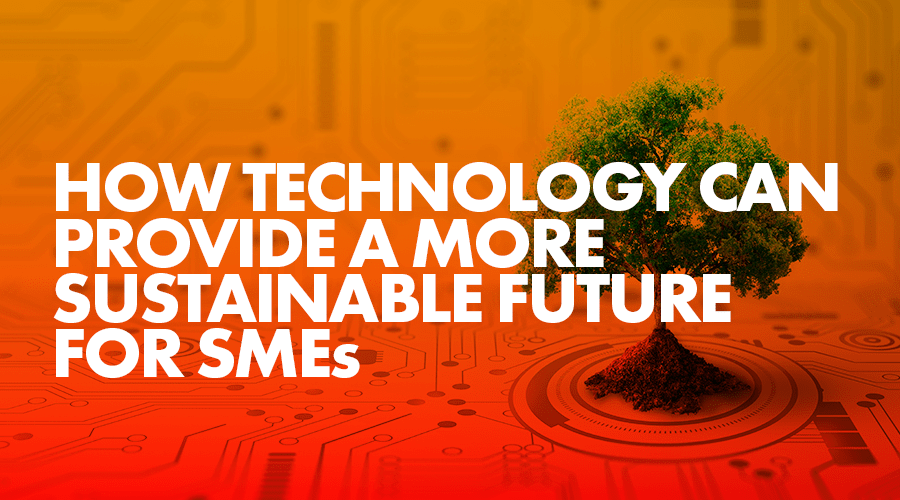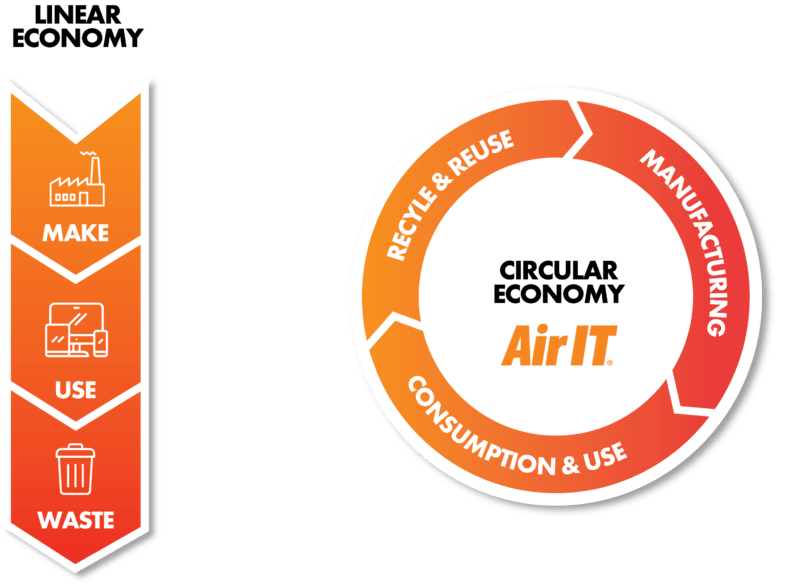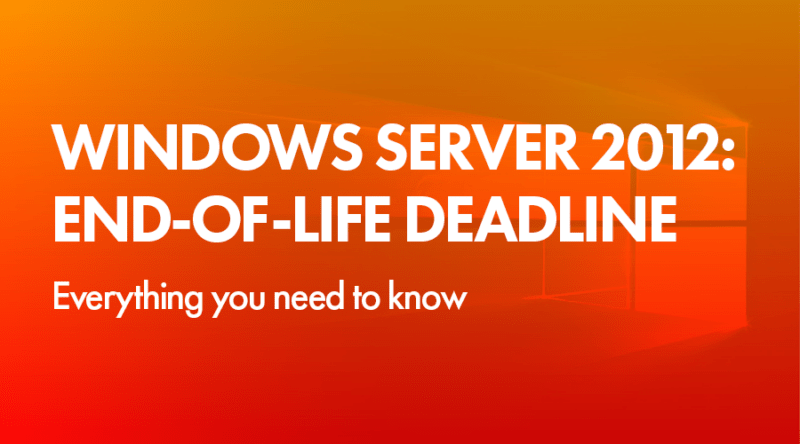With a growing emphasis on reducing carbon footprints, businesses are being called upon to contribute to a greener future. In a recent survey conducted by SME Climate Hub, small to medium enterprises (SMEs) are stepping up in the fight against climate change. However, a lack of resources prevents many from taking action. In our article, we explore several different ways that SMEs can reduce their carbon footprint through technology.

In a recent survey conducted by SME Climate Hub, small to medium enterprises (SMEs) are stepping up in the fight against climate change, however, a lack of resources prevents many from taking action. Small and medium-sized enterprises (SMEs) make up 99.9% of businesses globally, with 5.5 million in the UK alone, employing anywhere between 1 and 500 people. A recent article indicates that two-thirds of SMEs are worried about navigating climate change and often lack a long-term plan to decrease their carbon emissions. With the UK legally committed to hitting net zero by 2050, it’s important that businesses contribute to reducing carbon emissions as this will not only benefit the environment but also support compliance with regulations and industry standards.
The Environment Agency currently has regulations and policies in place that require certain companies to disclose their emissions, set reduction targets, or achieve net zero emissions by a particular date. Noncompliance with these standards can result in fines, and penalties, or could potentially harm your reputation as a brand. Last year, more than 30 companies were fined for breaching client change schemes in an effort to reduce emissions.
By integrating Green IT strategies, businesses can cut down on energy consumption, lower costs, and demonstrate their commitment to environmental sustainability, all while keeping up with the latest technological advancements. It only takes a few simple changes to take a more sustainable approach to technology (also known as Green IT), which can significantly help reduce carbon emissions by removing unsustainable practices and outdated technologies.
What is Green IT?
Green IT is the process of utilising technology and IT systems in a way that is environmentally responsible and energy efficient. The main objective of Green IT is to minimise the adverse effects of IT on the environment and improve sustainability, which includes reducing energy consumption, electronic waste production, and carbon emissions.
What can my business do to abide by Green IT?
There are many ways SMEs can use technology to reduce their carbon footprint. From energy-efficient hardware and cloud computing to remote work solutions and virtual meeting platforms, here are some of the things your business can do to promote sustainability through its investment in IT.
Embrace cloud solutions
Cloud technology solutions allow you to store and access data, software, and resources over the internet, rather than using physical servers. If your company currently stores all its data on in-house servers, you may wish to consider migrating to the cloud. It’s not only more eco-friendly but also more efficient, cost-effective, and ideal for remote or hybrid work settings.
Physical servers take up a lot of space, entail regular maintenance, and consume a significant amount of energy, due to the cooling systems needed to help them work best. Additionally, many companies don’t fully utilise their physical servers, resulting in wasted disk space and higher costs.
With cloud computing, all your data is stored securely in the cloud, and you only pay for the storage you use. This eliminates the need for in-house equipment other than the devices you use day-to-day, such as desktops and laptops.
When you store your data in a specialist data centre, you will not need to worry about energy consumption or maintaining, replacing, or recycling ageing server hardware. Although data centres have a significant environmental impact, it’s still much lower than the alternative of every business operating their own in-house server.
Remote working options
Implementing a remote or hybrid working policy can contribute to Green IT. Allowing employees to work remotely can greatly reduce their carbon footprint since they won’t need to commute to the office every day and with fewer office spaces in use, this can result in reduced energy consumption and lower energy emissions.
Modern technology has allowed remote working to become more accessible and efficient. Cloud technology solutions, communication tools like Microsoft Teams, and cloud-based phone systems can all contribute to higher productivity rates and increased employee satisfaction.
Remote work often promotes digital documentation and communication. For example, using cloud-based storage and productivity suites (such as Microsoft 365 and Google Workspace) can not only assist you in transitioning to a paperless work environment but also allows for increased productivity, reduced costs and the ability to access data anywhere, anytime. However, it’s important to note that even though applications like Microsoft 365 are in the cloud, they are not automatically backed up. If you’re not actively backing up your cloud data, you’re putting yourself at risk for potential data loss and downtime.
In our eBook, we explore the top five causes of data loss in the cloud and how a cloud backup solution could protect your business.
Refresh and recycle old IT equipment
When it’s time to part ways with your IT equipment, it’s important to ensure it is disposed of it in an environmentally conscious way. Recycling outdated technologies minimises electronic waste and its environmental impact, plus the hardware you no longer need can be used in new devices or donated to charities and schools. By extending the lifecycle of IT equipment through recycling, businesses can contribute to reduced carbon emissions and landfill waste.
At Air IT, we work with a trusted Waste Electrical and Electronic Equipment (WEEE) company to dispose of outdated technologies that are no longer required. If your business has ageing IT equipment that is no longer needed, you may wish to consider recycling options.
Alternatively, our Tech-as-a-Service (TaaS) offering revolutionises IT management with flexible, subscription-based contracts encompassing hardware, software, and services. TaaS empowers organisations to stay current, ensure financial stability, and meet environmental responsibilities, offering recycling options. By leasing new hardware, you can spread the cost over multiple terms and shifting you IT estate from CAPEX to OPEX.
At the end of the term you can return equipment for recycling and renew, endorsing a circular IT management approach. Our comprehensive services, from setup to warranty, service, and repair, contribute to your organisation’s sustainability goals, assisting in achieving Net Zero targets and fostering a circular economy, making your business more eco-friendly.

Utilise energy-efficient hardware
Choosing energy-efficient computers, laptops, and other hardware components for your business can help significantly reduce your business’s carbon footprint. Energy Star-certified devices and those designed for low power consumption during idle periods can collectively lead to substantial energy savings and contribute to a more environmentally friendly operation.
This proactive approach to selecting the appropriate hardware for your business aligns with the principles of Green IT, supporting both sustainability and potential cost savings for your business.
Implement managed print services
Businesses can adopt a Green IT approach by implementing a managed print solution. It is common for employees to print without considering their settings, resulting in printing mishaps such as the colour printing of 50-slide presentations with only one slide per page.
With a managed print solution, you can personalise your printing preferences. For instance, you can set default print settings for all users such as black-and-white double-sided printing. Additionally, you can minimise paper usage by implementing card or pin-controlled printing, which helps place accountability on employees and discourages unnecessary printing.
Alternatively, going paper-free and utilising digital document sharing and collaboration through cloud-based storage can help save time and reduce paper usage and waste.
What else can your business do?
Training your employees on the importance of Green IT and other sustainability issues will help them contribute to your goals. For example, encourage people to turn off lights, computers and other equipment when they’re not in use.
You may also wish to think about adopting renewable energy sources, such as solar panels. You could also replace fossil-fuelled company cars for electric vehicles and introduce green travel schemes to encourage or incentivise staff to use alternative forms of transportation.
Remember, sustainability is a continuous effort, and even the smallest changes can make a big difference over time. By adopting sustainable practices within your business, you can reduce your environmental footprint while also reaping potential financial benefits.
Stay ahead of the curve
With the UK legally committed to hitting net zero by 2050, it’s important to get ahead of the trend by ensuring your business abides by Green IT solutions as soon as possible. By implementing short-term actions, you can make an immediate positive impact on the environment.
To help you navigate the world of environmental sustainability, our Environmental, Social and Governance (ESG) Manager, Syiane Knowles, has compiled a collection of useful tools and resources:
- Supercritical – Carbon Removal Marketplace: A company dedicated to carbon removal and carbon accounting, allowing you to measure your carbon footprint and initiate a plan to reach net zero.
- Neutral Carbon Zone (NCZ): A platform that gives you the tools your company needs to make the transition to a carbon neutral business.
- The Essential Net Zero Vocabulary for Business Leaders: A list of essential terms related to carbon reduction, emission measurement, business and climate change, business climate regulations, and more.
- British Business Bank: Useful green business guides, jargon busters, and helpful explainers – everything you need to know to get your business started on the journey to net zero.
- SME Climate Hub: Additional tools and resources to help small businesses deliver on their climate goals.
If you require additional information regarding any aspect of this article, please get in touch or speak to your Account Manager and we will be more than happy to discuss your needs.




